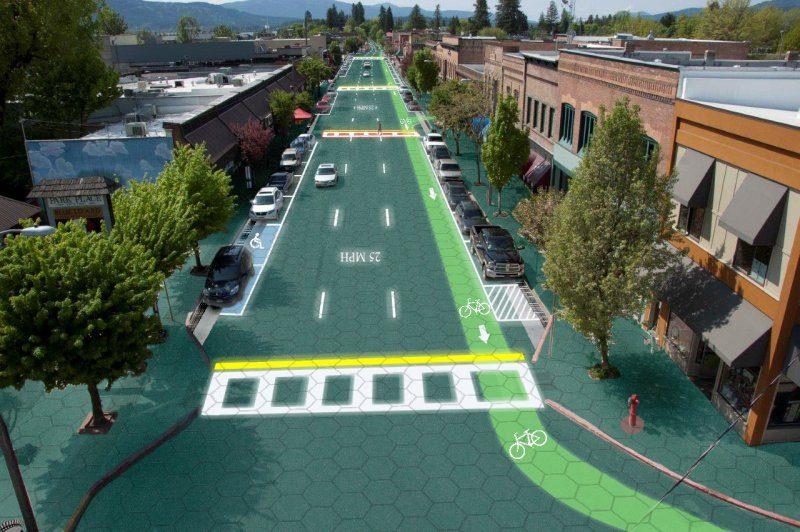
By Matthew Young
The first aptly-titled SolaRoad made its debut last November in the Netherlands, not far from Amsterdam. The road itself is a unique foray in pollution-free solar energy. Nearly one year later, the SolaRoad’s designers say the high-tech bike path is performing better than they expected.
In the first six months since it was installed, the SolaRoad has generated over 3,000 kilowatt-hours — or roughly the equivalent required for a single-person household for one calendar year.
Experts reckon that up to 20 percent of the Netherlands' roadways —140,000 kilometers or 87,000 miles — could accommodate the solar threading for a wider reach on a limitless solar draw.
How it works
The SolaRoad is a unique platform just 70 meters long — for now — that consists of several synthetic layers topped by 3-millimeter, glass-covered solar panels engineered to convert sunrays into energy — even on a perfectly cloudy day. Each transparent panel links into a network that optimizes absorbed solar radiation and redirects it into the local energy grid — to power street lamps, for example.
The engineers spent five years creating the system to be durable. The skid-resistant panels themselves are an innovation of concrete, rubberized silicon and the aforementioned glass. The end result is a stratified sandwich strong enough to sustain the systemic pressure dealt by a 12-ton load — like a fully-stocked fire truck. The panel material is non-adhesive, and the path itself is mounted at a slight tilt to allow for hassle-free rain runoff, washing and sweeping.
The longevity gauge for the lifespan of the SolaRoad’s panels with fully estimated wear-and-tear points to around two decades. Over 200,000 cyclists so far have gone the length of the SolaRoad. In this time, one flaw did manifest itself. A small yet pertinent section of the topside laminate experienced a degradation of integrity. The engineers intend to correct that.
Global extension
The trick is to continue to extend the SolaRoad in, through and beyond its launching pad of the village of Krommenie. The initial projection is to generate the aforementioned measure of power for every 70-meter extension. The primary goal was to perfect the road’s durability and functionality, which has been accomplished. Damage sustained by a single panel will affect that panel only: Each has an independent switch-off in the event of a functional compromise like a crack, soil coverage or overwhelming shade.
The umbrella concept of the SolaRoad is staggering to say the least. A nerve-net of sustainable green energy-focused routes will not solve the world’s collective energy crises. However, if enough of them are built, that could take a good chunk of the workload off the grid itself. Sten de Wit, spokesman for SolaRoad, the group behind the venture, told Al Jazeera that the annual yield of the project is expected to reach more than 70 kilowatt-hours per square meter.
A road as an energy source need not be a purely functional concept, either. Aesthetics have already been configured. It’s a matter of ingenuity and application. In 2014, a Dutch design studio installed a SolaRoad-type route: The energy it stored during daylight hours was transferred into a night-time LED cycle-guide display inspired by Vincent Van Gogh’s painting “Starry Night.”
Coming to America
The next step is to globalize the SolaRoad. Various factions in various nations and provinces are planning on and negotiating for the implementation of similar energy-centric roadways. Not surprisingly, California — an American state renowned for its sunny warmth and relatively mild weather patterns — is the first state to enter into a formal agreement with Holland. Expect a variation of the SolaRoad somewhere in the state within the next five or 10 years.
A proposed carless travel path called the CV Link is still in the planning stage for the low desert region west of Coachella through Palm Springs. It would be only natural to install a solar road parallel or inside the Link. Once it becomes a reality, momentum for further stateside applications will increase.
Additionally, two engineers in Idaho have developed a solar panel for roadway use. Now a decade old, their innovation — secured under the banner of Solar Roadways — was formally contracted by the Federal Highway Administration.
The prototype has yet to connect to soil, but time spent on fine-tuning the project will net a finely-tuned model to work from.
Solar Roadways’ website claims that greenhouse gases would be cut up to one-quarter of current emission output while energy production would increase three-fold should every American travel route — be it highway, freeway, surface street — somehow convert to a SolaRoad-type application. The company launched an IndieGogo campaign in 2014 to fund the first baby steps of its venture.
Future outlook
What would you do if you had the resources to adapt American roads to store power during the day and redirect it by night? Would you stop at roads or incorporate the technology elsewhere — bridges, towers, sides of office buildings? How long in terms of years, decades or centuries could such a concept require to vastly cut down domestic energy overuse?
Image credits: 1)-4) SolaRoad, used with permission 5) and 6) Solar Roadways
Matthew Young is a freelance automotive journalist and blogger hailing from Boston. He is passionate about everything on 4 wheels and new, emerging tech in the industry. When Matthew is not busy writing about cars or awesome new technology, he usually spends time fiddling with his camera and learning a thing or two about photography. You can reach Matthew @mattbeardyoung.
TriplePundit has published articles from over 1000 contributors. If you'd like to be a guest author, please get in touch!














